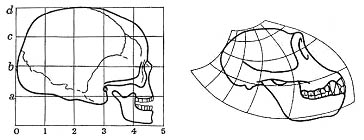Deformation grids illustrate and formalize shape differences between geometrical objects - an idea dating back to the Renaissance when Albrecht Dürer described the variation of human faces in his 1528 book "Vier Bücher von menschlicher Proportion".

D'Arcy Thompson revisits this approach with his "Cartesian transformations", which emphasize not the single specimen's geometry but rather on the mapping function from one form onto others.

While Thompson's deformation grids where drawn by hand, the geometric morphometric toolkit provides a formal algorithm to calculate such grids based on homologous landmark configurations. This interpolation algorithm, the so called "thin plate spline" (TPS), was borrowed from material physics and was introduced to morphometrics by Fred Bookstein. It generates a deformation grid (mapping function) between two point configurations that maps the actual points exactly and is otherwise as smooth as possible. This crucial notion of smoothness is operationalized by minimizing the "bending energy" of the deformation, which is the integral of its squared second derivatives. This attempt turns out to possess several convenient biomathematical properties and constitutes one pillar of the modern morphometric synthesis.
